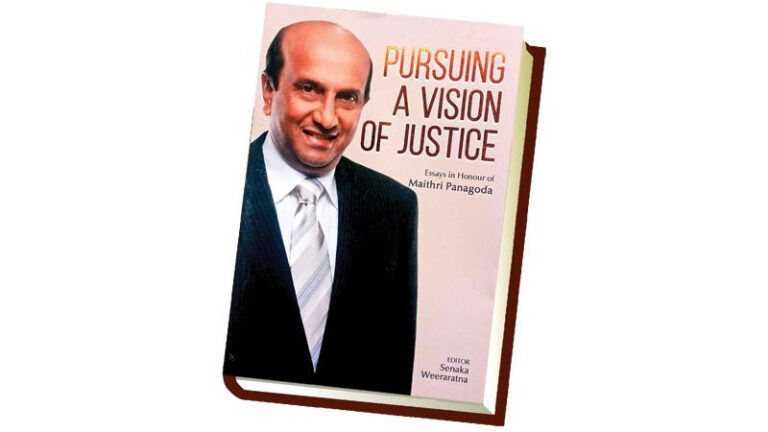
The trajectory of Maithri Panagoda’s life is simply amazing. He has confounded his most ardent admirers and even critics by the dizzy heights that he has reached in Australia. Whoever would have thought that a ‘game kolla’ (village lad) from Sri Lanka would be hobnobbing with the elite of Australia, one day. None except, perhaps, Maithri. He is a quiet achiever with steely determination.
One of his great strengths is his calm disposition and humility at all times, a balm to others. It is disarming and sweeping. He has not lost his head. His vision is multifaceted, among which is childhood ideal of being of service to others in the community. His succession is a reflection of the relentless pursuit and realisation of these noble goals.”
Maithri writes beautifully about his early home life, his likes and what he did as a youngster along with his siblings. Father was a doctor, mother, a teacher and later a vice principal of the village school. They were famously rich. They were highly regarded and well respected by the villagers. His and brother’s madness about owning a push bicycle and how they achieved was fantastic.
He says his mother was very protective and the father very strict. It is important for me to quote an incident which displays the integrity of Maithri and his father’s attitude being strict. Father “had a commanding presence” and children “feared and respected him.” He used the cane on Maithri once or twice. Punishment was usual.
At one instance, Maithri “got caught doing something unacceptable.” His father “got quite angry.” Father “looked everywhere for the cane, but could not find it. Maithri “ran out to the garden and brought a stick from a bush and handed it over” to the father. “He laughed and threw it away. Later, Maithri learnt that his “mother was responsible for the disappearance of the cane.”
Going through the whole book I come across seven remarkable, yet very relevant and significant, chapters. They, mostly for my review, are noteworthy. Chapters 4, 5, 21, 22, 23, 24 and 25 become preferential.
Ananda College
Chapter 5 deals with the Oration Speech. Maithri had been invited for this purpose by the Old Boys’ Union of Ananda College. This had been after 40 years since he had been a school boy. This was a tremendous honour for Maithri. The oration Speech was on Viva Ananda – Early History of Ananda College. The architect of founding this school was Colonel Henry Steel Olcott, the distinguished American Theosophist and President of the World Theosophical Society which was founded jointly with Helena Blavatsky in New York in 1875.
It is stated that the, “The founding of Ananda College in 1886 was the high point of the Buddhist revival, which stretched throughout the 19th century – a period of extraordinary progress and unexpected coincidences. Blatant discrimination against Buddhist (or, more correctly, non-Christians) and efforts to deny their children modern education in an environment free of proselytisation pressures, were to a great extent defeated. Ananda, and the many schools it inspired, under a formidable band of Principals and teachers changed the face of education over the ensuing decades providing opportunities for the exempted masses to compete”.
Initially what was important when it was commenced was the location the school came to be. It was established on November 1, 1886 at a private house with five rooms and with 37 students, at 61, Maliban street, Pettah, Colombo 2. It was named at the time as the Buddhist English School. In my opinion, reading Chapter 5 of the book is necessary to get an idea about Ananda College’s development, and its famous Principals throughout. Today, Ananda College is considered vast and the most important along with its well over 400 other schools in the country that cater to Buddhist education. Today, it has a student population over 6,000 at the present premises in Maradana.
Chapter 21 has been written late Sunil de Silva, our former Attorney General, and later NSW Crown Prosecutor, detailing that Maithri is multi-faceted, he being contributing “to the welfare of the Sri Lankan expatriate community based mainly in Sydney and the public honours he won for his notable community services, including the Order of Australia (AM) on the Queen’s Birthday. Maithri Panagoda is also one of the Sri Lankan born Australians bestowed with Australia’s Highest Award Order for Citizens and Professionals, no mean achievement.
Chapters 22 and 23 state chiefly about Maithri’s love for lyricism and song writing. Journalist and author Sachitra Mahendra pinpoints to Maithri’s talent for it in Chapter 22 so expressively. Dr. Ubeyasiri Wijeyananda Wickrama speaks about Maithri’s commitment and evolution of Sinhala Music – Its trends towards “Perceptive Arts” mode. (Subhavita Gita) in Chapter 23.
Chapter 24 is about late Judge C. G. Weeramanthry, as has been discussed earlier.
So significant is Chapter 25, penned by Dr. J. M. Swaminathan, regarding Prof. T. Nadaraja – Foundation Dean of the Faculty of Law, University of Ceylon.
